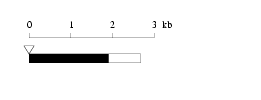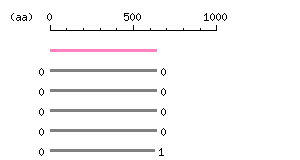
| HUGE |
Gene/Protein Characteristic Table for KIAA0113 |
|
Link to :
Rouge |
GTOP | SWISS-PROT/TrEMBL | GeneCards| RefDIC | |
| Features : DNA sequence | Protein sequence | Expression | Mapping | |
| Product ID : | ORK00020 |
|---|---|
| Accession No. : | D30755 |
| Description : | Nef-associated factor 1. |
| HUGO Gene Name : | TNFAIP3 interacting protein 1 (TNIP1) |
| Clone Name : | ha01652s1 [Vector Info] |
| Flexi ORF Clone : | pF1KA0113
 |
| Source : | Myeloblast cell line (KG-1) |
| Note : | We replaced ha01652, former representative clones for KIAA0113 with ha01652s1. (2002/5/10) |
Features of the cloned DNA sequence |
Description | |
|---|---|---|
Length: 2677 bp

|
| cloned DNA seq. | |
Warning for N-terminal truncation: | YES |
Warning for coding interruption: | NO |
Length of 3'UTR 766 bp Genome contig ID gi51511721r_150289701 PolyA signal sequence
(CATAAA,-24)
CGAATCATGGACATAAATCCAAGTTGAAGAAGATCFlanking genome sequence
(100000 - 99951)
AACATTCTGACTCATGTTCATTTATGCGCTAATGTTCCCCTGTCAACCCC
Chr f/r start end exon identity class ContigView(URL based/DAS) 5 r 150389701 150424849 17 99.7 Perfect prediction
Features of the protein sequence |
Description | |
|---|---|---|
Length: 636 aa
 |
|
The numbers on the left and right sides of a black line in the graphical overview indicate the lengths (in amino acid residues) of the non-homologous N-terminal and C-terminal portions flanking the homologous region (indicated by the black line), respectively.
No significant homologues
| Motif_DB | interpro_ID | From | To | Entry | Definition |
|---|---|---|---|---|---|
| None | - | - | - | - | - |
| Method | No. | N terminal | transmembrane region | C terminal | type | length |
|---|---|---|---|---|---|---|
| - | - | - | - | - | - | - |
Expression profile |
Description | |
|---|---|---|
RH mapping information |
Description | |
|---|---|---|
| : 5 |
| : Stanford G3 | |
| : CCCCTTCCTTCAAAACCTCCC | |
| : AGACAAACCCACACTTCCCAC | |
| : 159 bp | |
| : 95 °C |
|
How to obtain KIAA clone(s) Back to the HUGE Protein Database homepage 
| |